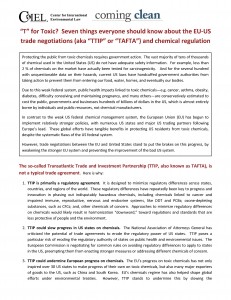
Protecting the public from toxic chemicals requires government action. The vast majority of tens of thousands of chemical used in the United States (US) do not have adequate safety information. For example, less than 2 % of chemicals on the market have actually been tested for carcinogenicity. And for the several hundred with unquestionable data on their hazards, current US laws have handcuffed government authorities from taking action to prevent them from entering our food, water, homes, and eventually our bodies.
Due to this weak federal system, public health impacts linked to toxic chemicals—e.g. cancer, asthma, obesity, diabetes, difficulty conceiving and maintaining pregnancy, and many others—are conservatively estimated to cost the public, governments and businesses hundreds of billions of dollars in the US, which is almost entirely borne by individuals and public resources, not chemical manufacturers.
In contrast to the weak US federal chemical management system, the European Union (EU) has begun to implement relatively stronger policies, with numerous US states and major US trading partners following Europe’s lead. These global efforts have tangible benefits in protecting US residents from toxic chemicals, despite the systematic flaws of the US federal system.
However, trade negotiations between the EU and United States stand to put the brakes on this progress, by weakening the stronger EU system and preventing the improvement of the bad US system.
